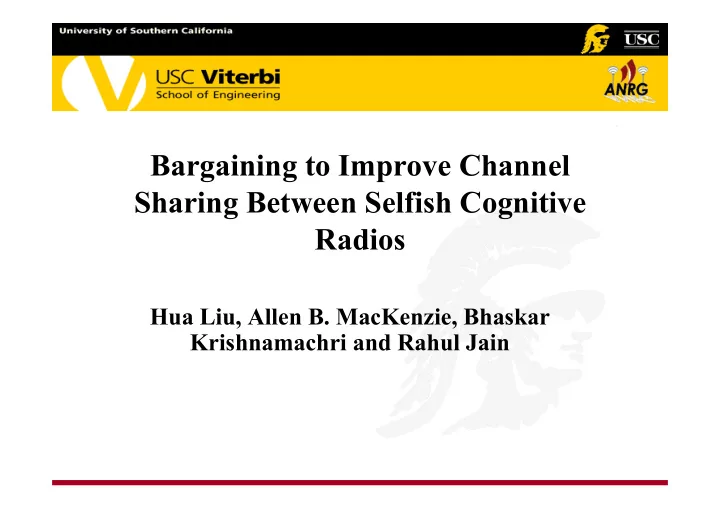

Bargaining to Improve Channel Sharing Between Selfish Cognitive Radios Hua Liu, Allen B. MacKenzie, Bhaskar Krishnamachri and Rahul Jain
Road Map • Scenario • Problem Formulation • Nash Equilibrium Analysis • Nash Bargaining Solution • Truthfulness Consideration • Future work: Implementation of Nash Bargaining Solution • Conclusion
Overview of the scenario • We consider a case with two users sharing two channels • Each user has his own valuation on each channel if he occupies the channel alone • If two users share the same channel, each of them gains half of their original channel valuation • Channel users make decisions in a distributed fashion
Problem Formulation • Payoffs • Original Table game • Affine transformations of payoffs
The Nash Equilibrium Analysis • The 2D plane is divided into 7 regions 4 1 (C2,C1) (C1,C1) 2 5 7 3 (C2,C1) (C1,C2) 1/2 2 6 (C1,C2) (C2,C2) 2 1/2
Nash Bargaining Solution: Incentives • Nash Bargaining solution is the only outcome that can satisfy: – Pareto efficiency – Symmetry – Invariance to equivalent payoff representations – Independence of irrelevant alternatives
Nash Bargaining Solution: Basis • Convexify the payoff region: coordination signal – Time is slotted. At the beginning of each slot, the coordinator uniformly generates a random number s between 0 and 1, which is observed by both players – For the pre-agreed value α (between 0 and 1) • If s ≤ α , C1 P1 and C2 P2 • Otherwise, C1 P2 and C2 P1 • Disagreement point is the Nash Equilibrium Point
Nash Bargaining Solution Analysis 4 1 Formulation: Efficient 2 5 7 3 Objective: choose α such that the Nash 1/2 2 6 bargaining result is maximized 2 1/2
Nash Bargaining Solution Performance For case 1:
Nash Bargaining Solution Performance • For case 7
Truthfulness Consideration • Motivation to consider truthfulness • Model the user’s “behavior” and “belief” – Behavior (objectively): • Lying • Truth-telling – Beliefs (subjectively): • Suspicious • Gullible
Three truthfulness Models • Three truthfulness models: – M1: Lying prone model: if a user will not lose anything by lying, he/she will lie – M2: Neutral model: if a user can possibly gain and never lose by lying, the user will lie – M3: Truth telling prone model: if a user doesn’t lose by telling the truth, he/she will NOT lie
Neutral Model Analysis • We consider M2 (Neutral Model) • In this particular problem, a user will lie if and only if the following two conditions hold: – Incentive Condition – Risk Aversion Condition • Two theorems
Two theorems about truthfulness with M2 • Theorem 1 – In the non-cooperative game with the gullible user assumption, truthfulness for both users is ensured under the neutral model (M2) • Theorem 2 – Truthfulness is not ensured in current Nash bargaining mechanism under the neutral model (M2)
Conclusions on truthfulness consideration • Truthfully reporting channel valuations is not incentivized in the current Nash bargaining mechanism • To implement the Nash bargaining solution, new mechanism is needed • Nash implementation of the Nash bargaining solution
Nash Implementation • Nash implementation of the Nash bargaining solution: – Nash implementation is not a dominant strategy implementation. Therefore, it does not guarantee truthfulness. Instead, Nash implementation guarantees that with rational players, the outcome has to be the Nash bargaining solution. – An extensive game form with perfect information and chance moves can implement the Nash bargaining solution exactly
Nash Implementation for Two Players • SPE implementation of the Nash bargaining Solution – Phase 1 • Player 1 specifies a point X • Player 2 specifies a point Y – Phase 2: A trial between X and Y • Player 1 specifies a real number r between [0,1] • Player 2 may concede, challenge or counter by specify t r ≤ t ≤ 1 – If player 2 concedes, X is the chosen point from this phase – If player 2 challenges, 1 must concede (in which case Y is chosen), or else specify r’>r and allow 2 to choose between r’X and Y – If player 2 conters, 1 may choose between tX and Y Reference: J.V. Howard, “A social choice rule and its implementation in perfect equilibrium”, JET ‘92, 142-159
Nash Implementation for Two Players – Phase 3 • Player 1 may alter the chosen point to Q • Player 2 may alter the chosen point to Q – Phase 4 • We call it “necessary” only if r’Y or tX or Q has been chosen. If it is necessary, the players in turn specify a point. If player i specifies q_i, then Q is ½ (q_1 + q_2) Reference: implementation for three and more players can be found in Naeve, Jörg “Nash Implementation of the Nash Bargaining Solution by a Natural Mechanism ”, 1998
Conclusions and Future Work • Conclusions – Formulated the channel sharing game – Analyzed the Nash equilibrium of the game – For the inefficient Nash equilibria, propose Nash Bargaining solution with a coordination signal. NBS guarantees 100% utilization of the channel resource. – Discussed truthfulness of the Nash bargaining solution • Future work: – Nash implementation of the Nash bargaining solution – Multiple dimension cases: multiple users and multiple channels
Recommend
More recommend